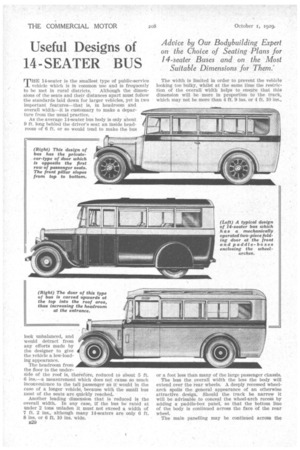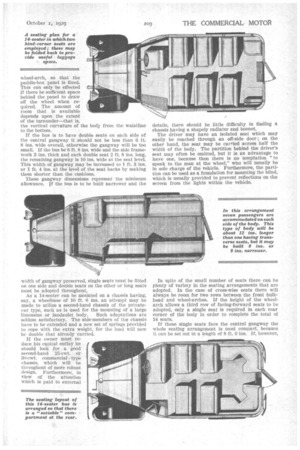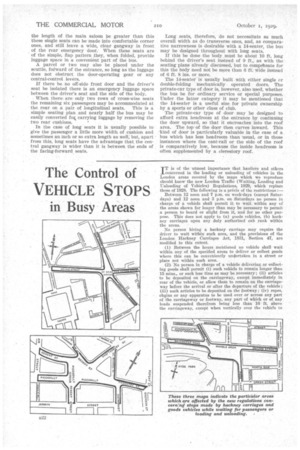Useful Designs of 14 SEATER BUS
Page 54

Page 55

Page 56

If you've noticed an error in this article please click here to report it so we can fix it.
Advice by Our Bodybuilding Expert on the Choice of Seating Plans for 14-seater Buses and on the Most Suitable Dimensions for Them:
THE 14-seater is the smallest type of public-service vehicle which is in common use and is frequently to be met in rural districts. Although the dimensions of the seats and their distances apart must follow the standards laid down for larger vehicles, yet in two important features—that is, in headroom and overall width—it is customary to make a departure from the usual practice.
As the average 14-seater bus body is only about 0 ft. long behind the driver's seat an inside headroom of -6 ft. or so would tend to make the bus
look unbalanced, and would detract from any efforts made by the designer to give the vehicle a low-loading appearance.
The headroom from the floor to the underside of the roof is, therefore, reduced to about 5 ft.
6 ins.—a measurement which does not cause so much inconvenience to the tall passenger as it would in the case of a longer vehicle, because with the small bus most of the seats are quickly reached.
Another leading dimension that is reduced is the overall width. In any case, if the bus be rated at under -2 tons unladen it must not exceed a width of
7 ft. 2 ins., although many 14-seaters are only 6 ft. 8 ins. or 6 ft. 10 ins. wide. B20 The width is limited in order to prevent the vehicle looking too bulky, whilst at the same time the restriction of the overall width helps to ensure that this dimension will be more in proportion to the track, which may not be more than 4 ft. 9 ins. or 4 ft. 10 ins., or a foot less than many of the large passenger chassis.
The less the overall width the less the body will extend over the rear wheels. A deeply recessed wheelarch spoils the general appearance of an otherwise attractive design. Should the track be narrow it will be advisable to conceal the wheel-arch recess by adding a paddle-box panel, so that the bottom line of the body is continued across the face of the rear wheel.
• The main panelling may be continued across the
wheel-arch, so that the paddle-box panel is fixed. This can only be effected if there be sufficient space behind the panel to draw off the wheel when required. The amount of room that is available depends anon the extent of the turnunder—that is, the vertical curvature of the body from. the waistline to the bottom.
If the bus is to have double seats on each side of the central gangway it should not be less than 6 ft. 8 ins, wide overall, otherwise the gangway will be too small. If the bus be.6 ft. 8 ins, wide and the side framework 3 ins, thick and each double seat 2 ft. 8 ins, long, the remaining gangway is 10 ins, wide at the seat level. This width of gangway may be increased to 1 ft. 3 ins. or 1 ft. 4 ins, at the level of the seat backs by making them shorter than the cushiOns.
These gang-way dimensions represent the minimum allowance. If the bus is to he built narrower and the
width of gangway preserved, single seats must be fitted on one side and double seats on the other or long seats must be adopted throughout.
As a 14-seater can be mounted on a chassis having, say, a wheelbase of 10 ft. 6 ins.. an attempt may be made to utilize a second-hand chassis of the privatecar type, such as is used for the mounting of a large limousine or landaulet body. Such adaptations are seldom satisfactory. The side-members of the chassis have to be extended and a new set Of springs provided to cope with the extra weight, for the load will now be double That already carried.
If the owner must reduce his capital outlay he should look for. a good second-hand 25-cwt. or 30-cwt. commercial type chassis, which will be throughout of more robust design. Furthermore, in view of the attention which is paid to external details, there should be little difficulty in finding a chassis having a shapely radiator and bonnet. The driver may have an isolated seat which may easily be reached through an off-side door ; on the other hand, the seat may be carried across half the width of the body. The partition behind the driver's seat may often be omitted, but it is an advantage to have one, because then there is no temptation "to speak to the pan at the wheel," who will usually be in sole charge of the vehicle. Furthermore, the partition can be used as a foundation for mounting the blind, which is usually provided to prevent reflections on the screen from the lights within the vehicle.
In spite of the small number of seats there can be plenty of variety in the seating arrangements that are adopted. In the case of cross-wise seats there will always be room for two rows between the front bulkhead and wheel-arches. If the height of the wheelarch allows a third row of facing-forward seats to be adopted, only a single seat is required in each rear corner of the body in order to complete the total of 14 seats.
If these single seats face the central gangway the whole seating arrangement is most compact, because it can be set out in a length of 8 ft. 6 ins. If, however, the length of the main saloon he greater than this these single seats can be made into comfortable corner ones, and still leave a wide, clear gangway in front of the rear emergency door: When these seats are of the simple, flap pattern they, when folded, provide luggage space in a convenient part of the bus.
A parcel or two may also be placed under the scuttle, forward of the entrance, so long as the luggage does not obstruct the door-operating gear or any central-control levers.
If there be no off-side front door and the driver's seat be isolated there is an emergency luggage space between the driver's seat and the side of the body.
When. thereare only two rows of cross-wise seats the remaining six passengers may be accommodated at the rear on a pair of longitudinal seats. This is a simple seating plan and nearly half the bus may be easily converted fat carrying luggage by removing the two rear cushions.
In the ease of long seats it is usually possible to give the passenger a little more width of cushion and sometimes an inch or so extra length as well, but, apart from this, long seats have the advantage that the central gangway is wider than it is between the ends of the facing-forward. seats.
Long seats, therefore, do not necessitate so much overall width as do transverse ones, and, as comparative narrowness is desirable with a 14-seater, the bus may be designed throughout with long seats.
If this be done the body must be about 10 ft. long behind the driver's seat instead of 9 ft., as with the seating plans already discussed, but to compehsate for this the body need not be more than 6 ft. wide instead of 6 ft. 8 ins, or more.
The 14-seater is usually built with either single or double-folding mechanically operated doors. The private-car type of door is, however, also used, whether the bus be for ordinary service or special purposes. Under the latter category it may be mentioned that the 14-seater is a useful size for private ownership by a sports or other class of club.
The private-car type of door may be designed to afford extra headroom at the entrance by continuing the door upward, so that it encroaches into the roof area. The top of the door then curves inward. This -kind of door is particularly valuable in the case of a bus which has less headroom than usual, or in those instances where the cant-rail or the side of the roof Is comparatively low, because the inside headroom is often supplemented by a clerestory roof.






















































































































